| Cas No.: | 2121-12-2 |
| Chemical Name: | [1,3]Dioxolo[4,5-j]pyrrolo[3,2,1-de]phenanthridinium,4,5-dihydro-2-hydroxy- |
| Synonyms: | [1,3]Dioxolo[4,5-j]pyrrolo[3,2,1-de]phenanthridinium,4,5-dihydro-2-hydroxy-;Ungerimine;Lycobetaine |
| SMILES: | OC1=CC2=C3[N+](=CC4=CC5OCOC=5C=C4C3=C1)CC2 |
| Formula: | C16H12NO3+ |
| M.Wt: | 266.27138 |
| Purity: | >98%, Standard References Grade |
| Sotrage: | 4°C for 1 year, -20°C for more than 2 years |
| Description: | Ungeremine, a phenanthridine type alkaloid, is extracted of the bulbs of Pancratium Illyricum. Ungeremine effectively targets mammalian as well as bacterial type I and type II topoisomerases. Ungeremine displays cytotoxic activity towards the 9 cancer cell lines, including drug-sensitive and MDR phenotypes. Ungeremine induced ferroptosis, necroptosis, autophagy as well as apoptosis mediated by caspase activation, MMP alteration and increase ROS production[1][2]. |
| References: | [1]. Casu L, et al. Ungeremine effectively targets mammalian as well as bacterial type I and type II topoisomerases. [2]. Mbaveng A, et al. Cytotoxicity of ungeremine towards multi-factorial drug resistant cancer cells and induction of apoptosis, ferroptosis, necroptosis and autophagy. Phytomedicine. 2019 Jul;60:152832. |

 To enhance service speed and avoid tariff delays, we've opened a US warehouse. All US orders ship directly from our US facility.
To enhance service speed and avoid tariff delays, we've opened a US warehouse. All US orders ship directly from our US facility.




















